It’s hard to believe it’s been seven years since I launched my customer experience consultancy, Heart of the Customer, way back when CX was still in its infancy.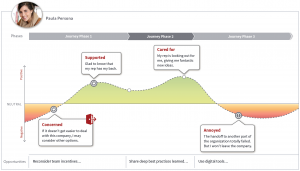
At that time, when I first wrote Customer Journey Maps – the Top 10 Requirements, I didn’t know the post would be viewed hundreds of thousands of times, and reposted around the world. But I did know that customer experience as a discipline – given its proven ability to boost customer loyalty and company results – was here to stay.
I enjoyed revisiting and updating the post back in 2015, but in the intervening years, the world has changed, the CX industry has evolved, research methodology has gotten more nimble, and technology has advanced. (And yet, somehow, none of us has aged a day – it’s uncanny!)
So it’s time once again to refresh the content. I am proud that the underlying philosophy and framework remains solid and consistent, but I’ve tweaked some terminology, techniques, guidelines, and examples.
In short, it’s an oldie, but a goodie, and I hope that regardless of whether you’re rereading it or encountering it for the first time, you will come away with something new and helpfulUnderstanding your customer experience is the key to improving it…and to reaping the financial rewards that go hand in hand with increasing customer satisfaction and loyalty. And the best way to find out what customers do, think, and feel while interacting with your company is to create a customer journey map.
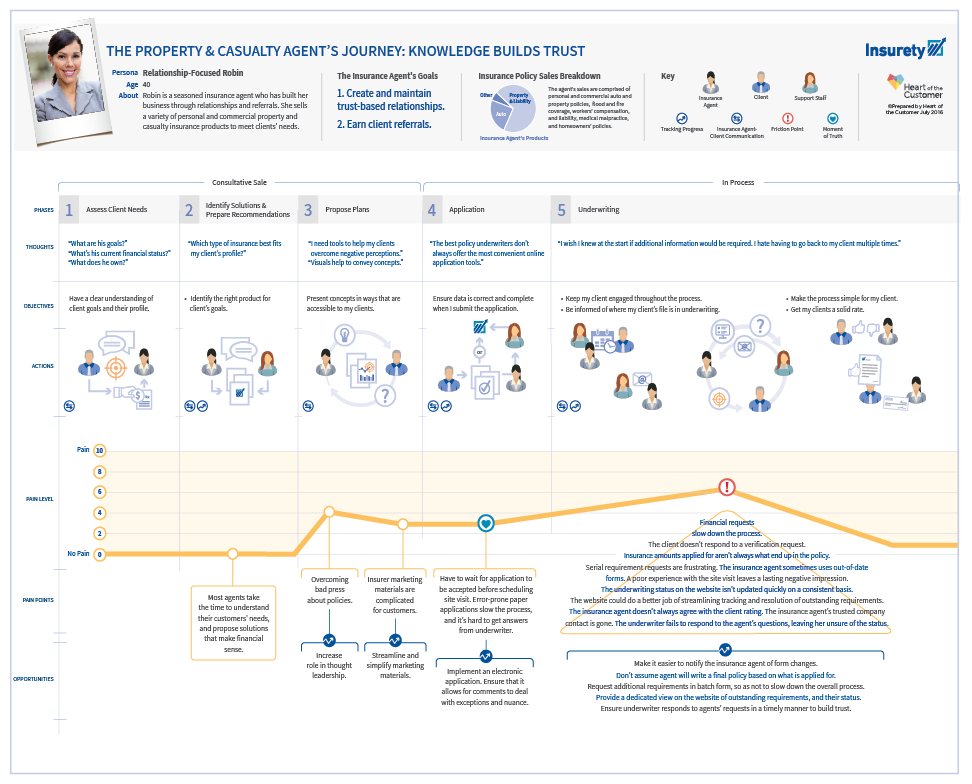
These visual representations show how a customer uses your product or service, or the decision-making process that turns a potential user into a customer. Undertaking the journey mapping process carries benefits that go way beyond the creation of a singular document, but here we will focus only on the maps themselves.
Guidelines are valuable because there is no “standard” map, since there is no “standard” customer experience. But not all journey maps are created equal. The best maps are highly customized, documenting your customer’s journey, as it is today, through your customer’s eyes. This allows you to easily identify where to focus your resources in the future, and the most cost-effective initiatives to implement to generate the greatest return on your investment (ROI) and the largest increase in customer loyalty.
The visual appeal of the document is extremely important, but the specific style is less so. You can build a map following high-quality design principles or use smiley faces. You can make it an engaging work of art or scribbles on a napkin. Ultimately, what is going to matters most is the content, and the integrity of the process used to compile it.
In this post, I’ll detail the criteria used to design and build customer journey maps that can accelerate your customer experience program, focusing on the 10 critical components all great customer journey maps share. The examples we’ve peppered throughout the post show actual Heart of the Customer journey maps that incorporate these criteria.
Here’s what you need to include for an effective, actionable, customer-focused journey map:
1. Represent Your Customer’s Perspective
A great customer journey map must represent the experience as your customer sees it, not the way you think they see it. That means it will often include aspects out of your direct control, such as social media influences, web searches, and steps your customers take before you even enter the picture.
For example, while studying the software purchase process for a large B2B client, Heart of the Customer – much to our client’s surprise – discovered that the vast majority of clients and prospects relied extensively on their own networks to create their list of vendors, ignoring conference trade shows, Google searches, and other more traditional forms of marketing.
While those channels were employed later in the purchase process, our discovery revealed that if the company didn’t win at “word of mouth,” they lost before they even knew they were in the running. This invaluable insight allowed the company to avoid wasting resources on programs that weren’t really impacting their results – or their bottom line – and instead concentrate on more effective relationship-building efforts.
2. Do Your Research
You can’t rely on internal staff to build an accurate customer journey map. (Unless you employ a lot of mind-readers, in which case, go right ahead!) Depending on the scope of the journey, you’ll need interviews, ethnographies, surveys, and/or other types of customer research to figure out what’s really going on. Start with qualitative research, as your customer’s touchpoints often involve interactions and emotional responses that will be a surprise. We always begin there, then for some projects, follow up with quantitative surveys to confirm the results.
Some companies bring in customers to work hand in hand with employees to build the map, but care must be taken in that scenario to avoid the bias that results from a small or tainted sample. This approach typically works best with B2B companies that want to focus on a specific journey, such as customer support. In most cases, it’s best to do customer research first, then build on the information gathered.
3. Recognize and Represent Customer Personas
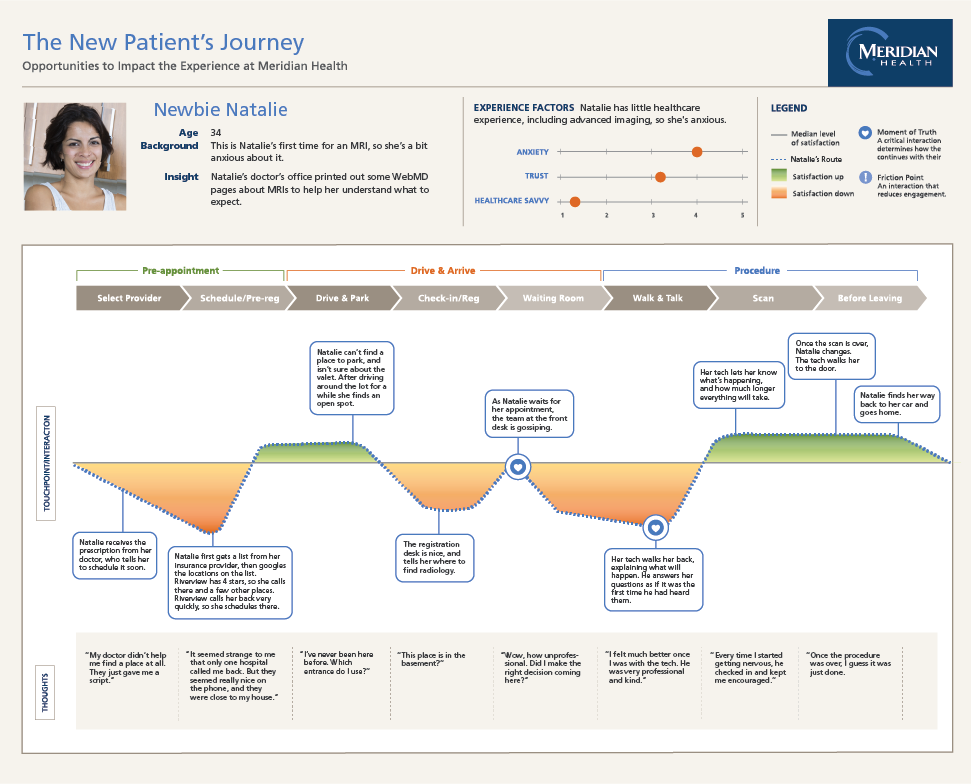

Different customers have very different experiences. For instance, while mapping how consumers purchase health insurance, we found that while one segment of customers spent only a couple of hours on research, another invested six weeks and used completely different tools. A great customer journey map doesn’t lump those two segments together, because the result wouldn’t accurately reflect the experience of either.
The solution is to identify qualities and journey experiences customers within a segment share, then use that data to build out a persona that represents that segment and brings their experiences to life.
If you have already identified segments, use those in your research. If you haven’t, use your qualitative research to uncover different personas, which you can refine in the quantitative phase.
4. Include Customer Goals
A great customer journey map illustrates what your customers are trying to accomplish at each stage of their experience, and reflects whether those goals evolve as the journey progresses. For example, when studying a health care journey for a hospital, we found that in the early stages, one persona focused extensively on understanding everything involved with the journey, whereas a different persona was just focused on getting through the process as quickly as possible. It’s obvious how that revelation made it much easier to design cost-effective initiatives to meet each persona’s needs.
5. Focus on Emotions
It’s impossible to overstate the importance emotions play in any customer experience, whether B2B or B2C, because emotions are the key motivator behind every decision we make. Even when it comes to the largest organizations, ultimately, every decision is still made by a human being.
Great customer journey maps spotlight these emotions. I’m not a fan of using the smiley and frowning emojis prevalent in many journey maps, but the information does need to be conveyed somehow. Heart of the Customer always uses professional designers, but there are now so many graphic tools and options readily accessible to anyone with an internet connection that using smiley faces seems needlessly inadequate and, frankly, a little lazy.
Take advantage of color, style, and graphic elements to put viewers of your map in your customer’s shoes and convey how customers feel throughout the journey.
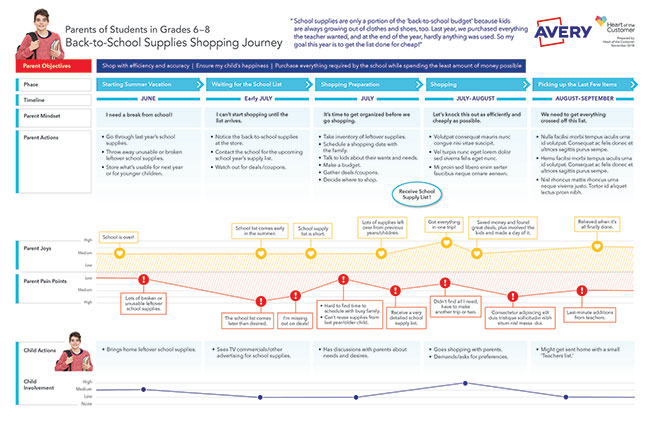 6. Indicate Touchpoints
6. Indicate Touchpoints
One reason many clients choose to create a customer journey map is to better understand the order and type of each and every touchpoint – those times when your customer and your company interact – including those over which you have little direct control, such as the online research or referral from a friend that might lead a customer to your website early in their shopping journey. In fact, these “external” touchpoints are often some of the most important parts of the journey, and key to understanding friction that occurs.
Internal journey mapping done without capturing the voice of the customer is unlikely to take these customer steps into account – and therefore unlikely to be able to address and improve them – yet another reason involving real customers in your mapping efforts is so important.
7. Highlight Moments of Truth
Just as not all maps are created equal, not all interactions in the customer journey are equally important. Great journey maps reveal those Moments of Truth that have a disproportionate impact on a customer’s overall perception of the journey, and in doing so, pinpoint the key opportunities where your improvement efforts will provide the greatest return. The outcome of these critical interactions might well determine whether a customer stops doing business with you or is so delighted they recommend you to their friends, family, and social media connections.
For one health care client, Heart of the Customer’s research revealed that problems during the hospital check-in process tainted the entire patient experience, even for patients that were otherwise quite satisfied with the care they subsequently received. In that circumstance, directly resources toward providing better care – a seemingly obvious way to improve customer satisfaction – would have little impact on loyalty. Removing the initial friction during the check-in process, however, increased customer loyalty and care ratings (for the same level of care) because it changed customers’ perception of the care received.
 8. Evaluate Your Brand Promise
8. Evaluate Your Brand Promise
Done right, journey mapping can reveal how your brand promise aligns with the actual customer experience you’re providing, as well as how to fix issues if you’re falling short. Do you sell your process as being effortless? Highly personalized? Affordable? A great customer journey map will show whether your customers believe you’re delivering – and if they think you’re not, how much their disappointment might be costing you in lost sales or increased expenses.
9. Measure Time
The length of a customer experience provides important context. Does a typical call last 30 seconds or 10 minutes? Did shoppers take an hour or a week to decide on a purchase? A great journey map recognizes that this information is essential, and is built around it.
10. Ditch the PowerPoint
The overarching themes of the story told by a journey map should be immediately obvious. But a great journey map is designed to be pored over and studied, with the nuances revealed in the details. Too many journey maps are created only for presentation on a screen, communicating basic information through concise bullet points. A great customer journey map defies those limitations.
Use a desktop publishing application and a professional designer to create your map so you can dive deeper, and more freely and effectively convey the richness of the customer experience.
There you have it, as promised: 10 points that highlight the critical components of any great customer journey map. But we customer experience pros recognize the benefits of going above and beyond in our efforts to delight, right?
1. Break the Experience into Phases
In longer journeys, customers are trying to accomplish different things, at different times, and in different ways. Document their mindset throughout, so you can tailor your customer experience to meet your customers’ needs at every stage.
For example, it’s typical for preliminary steps in a shopping journey to revolve around finding out what questions to ask, but later steps in the journey are more transactional. Keep tabs on what your customer wants from you, and when they want it.
2. That’s What She Said!
Including customer quotes – what they’re actually saying during and about the experience – isn’t strictly necessary, but I’ve found it really adds dimension to the experience, and helps employees relate to what the customer is going through.
3. Include Non-Customers
A pre-sales customer journey map should always include “the ones that got away,” i.e., the people who chose not to do business with you. Finding out where their experience differed from the people you successfully converted into customers is likely to shed a lot of light on the reasoning and emotions behind their decision-making process – and therefore illustrate where you should target your interventions.
For example, one Heart of the Customer journey map revealed that our client’s “non-customers” were typically people who relied on in-person meetings when making purchasing decisions – something our client didn’t offer at the time. That realization was critical to their improvement efforts, and yielded corresponding financial benefits.
4. Incorporate Your Other Voice of the Customer Components
Journey maps shouldn’t stand alone. Just as your maps can explain the findings from other methods of customer feedback, other methods of research can add richness to your journey maps. Factor in operational data, such as the length of the journey, error rates, or the number of support calls, to add explanatory power and context to your journey maps, especially when presenting to executives.
Keeping these 10+4 components in mind during your journey mapping will ensure you create a rich document that provides a solid foundation for your customer experience efforts. But make sure they don’t just gather dust on a shelf! Use what you’ve learned to drive action, manage your journey, and improve your business outcomes.
On our blog, we offer many more examples of how we apply these principles to benefit our clients. For additional details about our proprietary journey mapping process, download our journey mapping toolkit, watch our webinars, and peruse our authoritative journey mapping guidebook, How Hard Is It to Be Your Customer?
Register for our upcoming webinar on Customer Journey Maps: The Top 10 Requirements

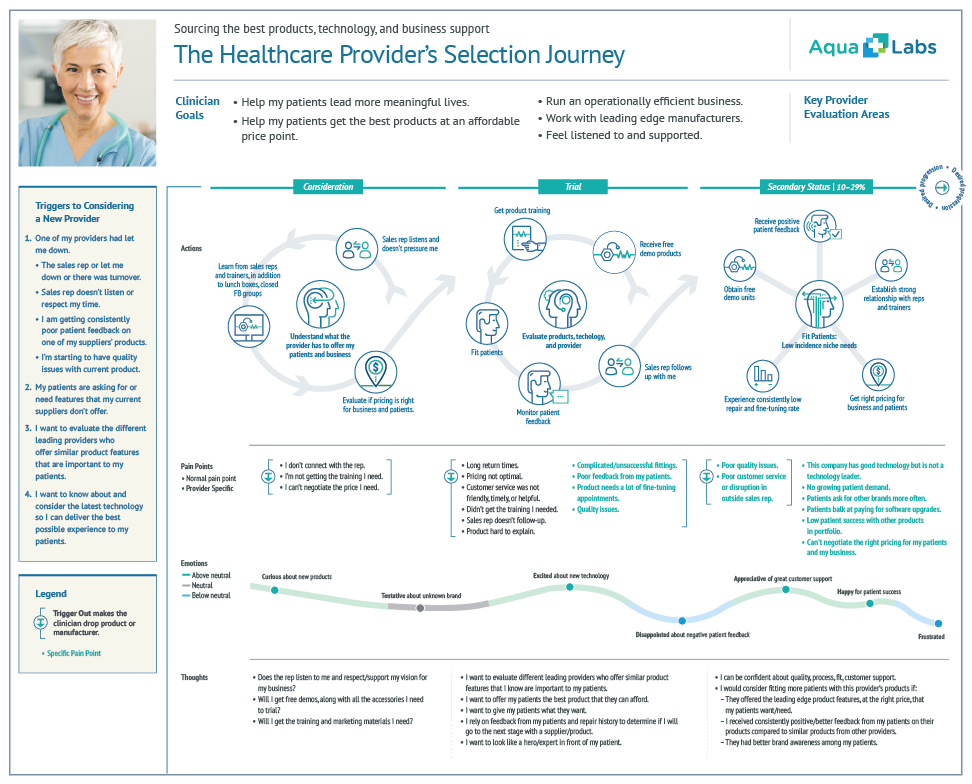
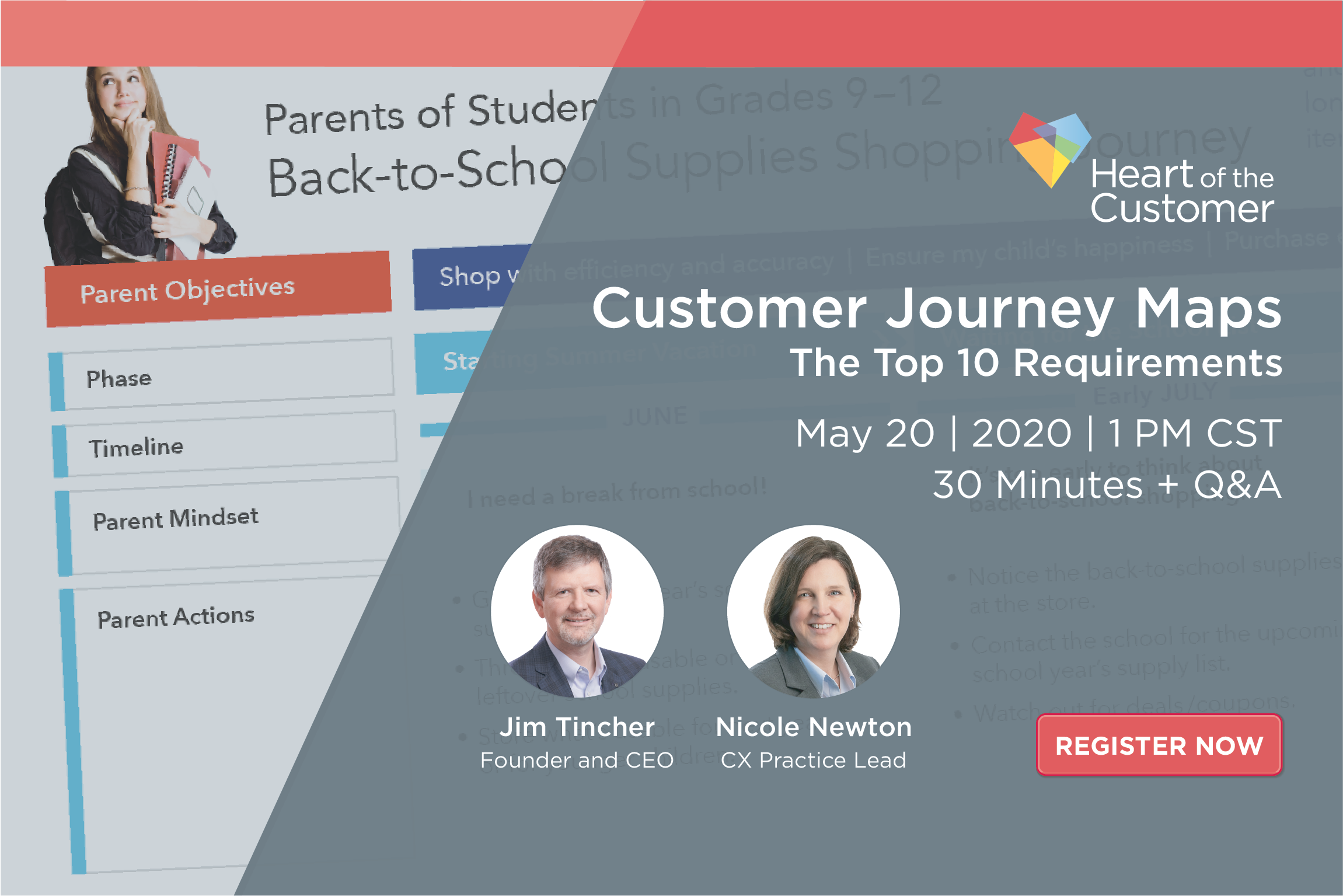



I think one also needs to be aware that overtime the journey can evolve and the issues shift. Recommend periodic revisiting the journey to insure it remains relevant.